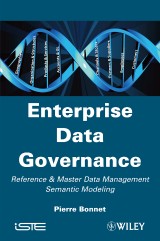Details

Enterprise Data Governance
Reference and Master Data Management Semantic Modeling1. Aufl.
|
139,99 € |
|
| Verlag: | Wiley |
| Format: | EPUB |
| Veröffentl.: | 04.03.2013 |
| ISBN/EAN: | 9781118622537 |
| Sprache: | englisch |
| Anzahl Seiten: | 320 |
DRM-geschütztes eBook, Sie benötigen z.B. Adobe Digital Editions und eine Adobe ID zum Lesen.
Beschreibungen
In an increasingly digital economy, mastering the quality of data is an increasingly vital yet still, in most organizations, a considerable task. The necessity of better governance and reinforcement of international rules and regulatory or oversight structures (Sarbanes Oxley, Basel II, Solvency II, IAS-IFRS, etc.) imposes on enterprises the need for greater transparency and better traceability of their data. <p>All the stakeholders in a company have a role to play and great benefit to derive from the overall goals here, but will invariably turn towards their IT department in search of the answers. However, the majority of IT systems that have been developed within businesses are overly complex, badly adapted, and in many cases obsolete; these systems have often become a source of data or process fragility for the business. It is in this context that the management of ‘reference and master data’ or Master Data Management (MDM) and semantic modeling can intervene in order to straighten out the management of data in a forward-looking and sustainable manner.</p> <p>This book shows how company executives and IT managers can take these new challenges, as well as the advantages of using reference and master data management, into account in answering questions such as: Which data governance functions are available? How can IT be better aligned with business regulations? What is the return on investment? How can we assess intangible IT assets and data? What are the principles of semantic modeling? What is the MDM technical architecture? In these ways they will be better able to deliver on their responsibilities to their organizations, and position them for growth and robust data management and integrity in the future.</p>
<p><i>Testimonials from the MDM Alliance Group xiii</i></p> <p><i>Foreword xxv</i></p> <p><i>Preface xxix</i></p> <p><i>Acknowledgements xxxix</i></p> <p><i>Introduction to MDM xli</i></p> <p><b>PART ONE: THE MDM APPROACH 1</b></p> <p><b>Chapter 1. A Company and its Data 3</b></p> <p>1.1. The importance of data and rules repositories 3</p> <p>1.2. Back to basics 6</p> <p>1.3. Reference/Master data definition 12</p> <p>1.4. Searching for data quality 19</p> <p>1.5. Different types of data repositories 27</p> <p><b>Chapter 2. Strategic Aspects 37</b></p> <p>2.1. Corporate governance 37</p> <p>2.2. The transformation stages of an IT system 42</p> <p>2.3. Sustainable IT Architecture 51</p> <p><b>Chapter 3. Taking Software Packages into Account 57</b></p> <p>3.1. The dead end of locked repositories 57</p> <p>3.2. Criteria for choosing software packages 59</p> <p>3.3. Impact for software vendors 63</p> <p>3.4. MDM is also a software package 65</p> <p><b>Chapter 4. Return on Investment 69</b></p> <p>4.1. Financial gain from improved data quality 69</p> <p>4.2. The financial gain of data reliability 71</p> <p>4.3. The financial gain of mastering operational risks 74</p> <p>4.4. The financial gain of IS transformation 77</p> <p>4.5. Summary of the return on investment of MDM 83</p> <p><b>PART TWO: MDM FROM A BUSINESS PERSPECTIVE 87</b></p> <p><b>Chapter 5. MDM Maturity Levels and Model-driven MDM 89</b></p> <p>5.1. Virtual MDM 89</p> <p>5.2. Static MDM 92</p> <p>5.3. Semantic MDM 95</p> <p>5.4. The MDM maturity model 100</p> <p>5.5. A Model-driven MDM system 103</p> <p><b>Chapter 6. Data Governance Functions 109</b></p> <p>6.1. Brief overview 109</p> <p>6.2. Ergonomics 111</p> <p>6.3. Version management 112</p> <p>6.4. The initialization and update of data by use context 114</p> <p>6.5. Time management 118</p> <p>6.6. Data validation rules 122</p> <p>6.7. The data approval process 128</p> <p>6.8. Access rights management 129</p> <p>6.9. Data hierarchy management 130</p> <p>6.10. Conclusion 131</p> <p><b>Chapter 7. Organizational Aspects 133</b></p> <p>7.1. Organization for semantic modeling 133</p> <p>7.2. The definition of roles 146</p> <p>7.3. Synthesis of the organization required to support the MDM 148</p> <p><b>PART THREE: MDM FROM THE IT DEPARTMENT PERSPECTIVE 151</b></p> <p><b>Chapter 8. The Semantic Modeling Framework 153</b></p> <p>8.1. Establishing the framework of the method 153</p> <p>8.2. Choosing the method 161</p> <p>8.3. The components of Enterprise Data Architecture 172</p> <p>8.4. The drawbacks of semantic modeling 178</p> <p>8.5. Ready-to-use semantic models 180</p> <p><b>Chapter 9. Semantic Modeling Procedures 187</b></p> <p>9.1. A practical case of semantic modeling: the address 187</p> <p>9.2. Example of Enterprise Data Architecture 199</p> <p>9.3. Semantic modeling procedures 202</p> <p><b>Chapter 10. Logical Data Modeling 215</b></p> <p>10.1. The objectives of logical modeling 215</p> <p>10.2. The components of logical data modeling 216</p> <p>10.3. The principle of loose-coupling data 217</p> <p>10.4. The data architecture within categories 221</p> <p>10.5. Derivation procedures 221</p> <p>10.6. Other logical modeling procedures 229</p> <p><b>Chapter 11. Organization Modeling 233</b></p> <p>11.1. The components of pragmatic modeling 234</p> <p>11.2. Data approval processes 235</p> <p>11.3. Use cases 239</p> <p>11.4. Administrative objects 243</p> <p>11.5. The derivation of pragmatic models to logical models 244</p> <p><b>Chapter 12. Technical Integration of an MDM system 247</b></p> <p>12.1. Integration models 248</p> <p>12.2. Semantic integration 254</p> <p>12.3. Data synchronization 258</p> <p>12.4. Integration with the BRMS 261</p> <p>12.5. Classification of databases and software development types 263</p> <p><b>Conclusion 267</b></p> <p><b>Appendix. Semantic Modeling of Address 271</b></p> <p>A.1. The semantic model 272</p> <p>A.2. Examples of screens generated by Model-driven MDM 277</p> <p>A.3. Semantic modeling and data quality 282</p> <p>A.4. Performance 282</p> <p>A.5. Lifecycle of the Address business object 282</p> <p>A.6. Insight into the XML schema 283</p> <p><i>Bibliography 285</i></p> <p><i>Index 287</i></p>
<p><strong>Pierre Bonnet</strong> is the co-founder of Orchestra Networks, a software editor specialized in Model-driven MDM. He is also the founder of the "Sustainable IT Architecture" and "MDM Alliance Group" communities.
Diese Produkte könnten Sie auch interessieren:

MDX Solutions

von: George Spofford, Sivakumar Harinath, Christopher Webb, Dylan Hai Huang, Francesco Civardi

53,99 €















